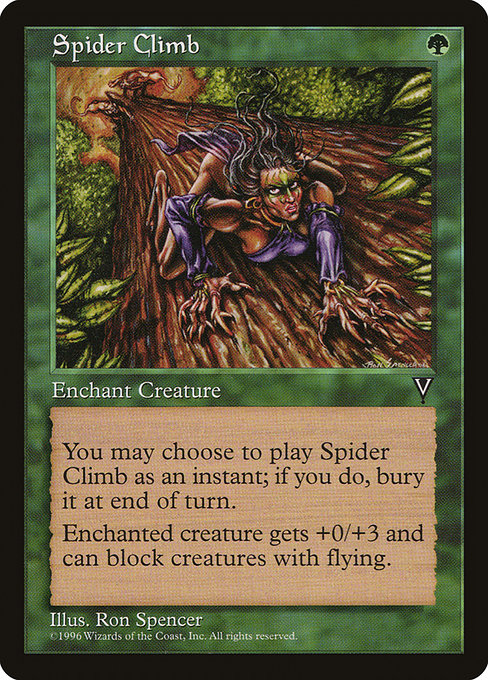
Image courtesy of Scryfall.com
Humor as critique: why a card like Spider Climb matters
MTG has always walked a tightrope between deep strategy and elegant simplicity. In the early days, a green aura that simply buffed a creature could be enough to swing a game, while today’s design sometimes leans into verbose text and intricate timing windows. Enter Spider Climb, a one-mana enchantment from Visions that wears its philosophy on its sleeve 🧙♂️🕷️. It’s a wink from the past—a reminder that complexity can be examined with a smile, even as players build around thousands of cards across dozens of formats. The card’s playful constraints invite a conversation about how much breathing room modern design should allow, and how humor can soften the sting when complexity creeps into otherwise friendly games 🔥💎.
What Spider Climb actually does (and how it sounds to a nodding fan)
Spider Climb is green through and through—a common enchantment aura with a deceptively punchy line of text. Its mana cost is a modest {G}, and its aura reads enchant creature. The flavor text is less about a spider’s web and more about weaving a strategy where timing, in particular, is everything. The notable twist is you may cast this spell as though it had flash. If you cast it any time a sorcery couldn't have been cast, the controller of the permanent it becomes sacrifices it at the beginning of the next cleanup step. Enchanted creature gets +0/+3 and has reach, letting it block flying threats. In short: a green aura that leans into timing, defense, and a modest defensive buff, all while reminding us that a single mana can carry a surprising amount of nuance.
Oracle text: You may cast this spell as though it had flash. If you cast it any time a sorcery couldn't have been cast, the controller of the permanent it becomes sacrifices it at the beginning of the next cleanup step. Enchant creature. Enchanted creature gets +0/+3 and has reach.
That combination—an aura you can cast with flash, a timing trap, a robust defensive stat line, and a reach extension—presents a tidy microcosm of MTG’s design tension. The “as though it had flash” clause is a humorous nod to players who crave tempo plays, while the potential mis-timing that triggers a sacrifice adds a playful risk. The +0/+3 boost is modest in raw numbers, yet reach adds real meta-game value, especially against white and blue skies full of flying critters. It’s a card that speaks volumes with a whisper, which is precisely the vibe humor cards aim for when they critique complexity without becoming a run-on lecture 🧙♂️⚔️.
Why humor cards can critique complexity without alienating players
Humor cards like Spider Climb punch up the conversation about complexity by offering a micro-lable of design critique that’s approachable. They don’t require a glossary of rules to understand; a player can glance the card and sense: “This is playing with timing, defense, and color identity in a way that feels almost affectionate toward the game’s quirks.” When players laugh at a rule like “cast as though it had flash,” they’re not shirking rules—they’re acknowledging that MTG’s vastness can be both exhilarating and overwhelming. That balance is essential for longevity: it invites new players to feel curious rather than overwhelmed, while gifting veterans a nostalgic wink that resonates across decades 🧠🎲.
Visions, as a 1997 set, sits at a moment in MTG’s history when design was exploring new ideas and letting flavor drive mechanics. Spider Climb’s common rarity and green identity reflect a period where color pie rules and straightforward combat buffing still reigned supreme. The art by Ron Spencer captures a undercurrent of whimsy that modern, high-definition cards sometimes chase with more literal storytelling. Reading Spider Climb today feels like leafing through a design sketchbook from a different era—one that reminds us to appreciate how far rules complexity has traveled, and how humor can keep us company along the way 🧙♂️🎨.
From card design to cultural moment
In the grand arc of MTG culture, humor cards act as sociable time capsules. They poke at the edges of complexity, inviting discussions about intelligible design, player agency, and the balance between power and restraint. Spider Climb doesn’t pretend to solve anything; it invites players to reflect on how a single, green enchantment can influence a game in both subtle and dramatic ways. The card’s evergreen vibe—blockers that can be cast with a hint of tempo, a buff that matters in the right moment, and a risk-reward clause that makes you think twice—fits nicely into a broader conversation about how to keep the game accessible even as it grows denser with every new expansion 🧙♂️🔥.
Brewing and desk-ready gear that pairs with nostalgia
As you mull over Spider Climb and its sly satire of timing, it’s the little rituals that keep MTG culture alive: brewing a deck with a nod to older sets, trading banter with friends, or simply enjoying a well-timed flash play that makes a rival groan and grin at the same moment. While you’re diving into flavor and timing, you might also want to refresh your desk space for long brewing sessions and tournament prep. A reliable gaming setup matters as much as a clever card—enter the gaming mouse pad that fits a tight desk footprint and holds up under hours of play. The product linked below is a playful counterpart to the card’s legacy—a practical, high-utility accessory that keeps you focused on the game, not the clutter.
Gaming Mouse Pad 9x7 Custom Neoprene with stitched edges
More from our network
- https://transparent-paper.shop/blog/post/common-pitfalls-for-new-digital-sellers/
- https://blog.zero-static.xyz/blog/post/pain-distributor-in-mtg-community-contests-and-themed-decks/
- https://blog.digital-vault.xyz/blog/post/machine-learning-clusters-chronozoa-mana-costs/
- https://crypto-acolytes.xyz/blog/post/telex-turns-everyone-into-a-wordpress-block-developer/
- https://transparent-paper.shop/blog/post/build-scalable-logo-template-kits-for-small-businesses/